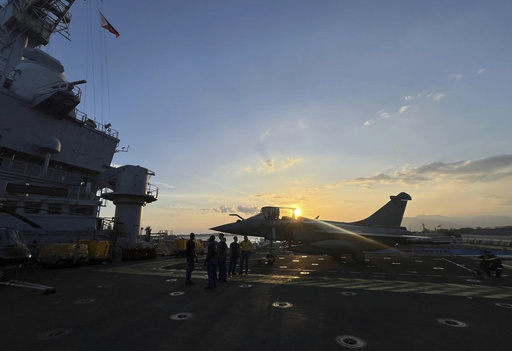
ABOARD THE CHARLES DE GAULLE, Philippines — On Sunday, France’s nuclear-powered aircraft carrier, accompanied by a fleet of warships, arrived in the Philippines after conducting military exercises with Filipino forces in the contentious South China Sea, an action likely to provoke a response from China.
The Charles de Gaulle docked on Friday at Subic Bay, a former U.S. naval facility located northwest of Manila, for a brief respite following over two months of active duty in the Indo-Pacific region. During its stay, the French carrier collaborated with allied nations to enhance contingency preparedness and bolster regional security, partnering with Filipino military forces, naval vessels, and fighter jets. On Friday, they performed maneuvers including anti-submarine warfare exercises and aerial combat training in the South China Sea, as confirmed by both Philippine and French officials.
French Ambassador to Manila, Marie Fontanel, emphasized the intention to strengthen partnerships with nations that share similar values, underscoring the importance of adhering to international law and ensuring free navigation in shared waters. Fontanel addressed the media on the flight deck of the Charles de Gaulle, amid several parked Rafale fighter jets, an assault helicopter, and a reconnaissance aircraft, with the flags of France and the Philippines prominently displayed.
“Our presence serves as an ongoing reminder of the necessity to promote and safeguard the principles that unite us — international law and collaborative efforts,” Fontanel stated. Last year, the French navy took a significant step by dispatching a frigate to engage in joint operations with U.S. and Philippine forces in the region. This involvement formed part of the largest military exercises conducted in recent years between American and Filipino allied troops, known as Balikatan, which included over 16,000 personnel.
China expressed strong disapproval of these joint exercises, accusing the Philippines of aligning with external nations, specifically referencing the United States and its allies, and warned that such drills could escalate tensions and threaten regional stability. France’s military presence in the Philippines and its ongoing initiatives highlight a commitment to reinforcing maritime cooperation in the Indo-Pacific, as noted by Armed Forces of the Philippines spokesperson Colonel Xerxes Trinidad.
The Charles de Gaulle, recognized as the only nuclear-powered aircraft carrier in the world besides those belonging to the U.S. Navy, led a task force that included three destroyers and an oil replenishment vessel during this historic visit to the Philippines, according to French authorities. France has been strengthening its military partnerships with the Philippines and other Southeast Asian countries at odds with China regarding territorial claims in the strategically essential waters, although officials maintain that these measures are not directed at any specific nation.
Nonetheless, China remains sensitive to the presence of foreign military forces, particularly those from the United States and its allies, conducting training exercises or maritime patrols within the South China Sea. Beijing asserts nearly the entire area as its own, despite not having publicly delineated its claim beyond a general outline depicted on maps. Chinese claims overlap with those of several other countries including the Philippines, Vietnam, Malaysia, Brunei, and Taiwan, resulting in long-standing territorial disputes. Furthermore, Indonesia has experienced tense confrontations with Chinese fishing vessels and coast guard operations in the Natuna Sea area.
In a recent incident, Australia lodged a formal protest after a Chinese J-16 fighter jet released flares near an Australian P-8 Poseidon surveillance aircraft, which was flying over the South China Sea. Fortunately, the Australian aircraft remained unscathed, and none of the crew members were hurt. In response, a spokesperson for China’s Foreign Ministry accused the Australian plane of “deliberately” intruding into airspace linked to the disputed Paracel Islands, contested by both China and Vietnam.
In late 2023, the French and Philippine defense ministers formalized a cooperative agreement aimed at enhancing military partnership and joint operations. Discussions initiated last year between France and the Philippines regarding a defense pact would enable military exercises on each other’s territory. The French delegation has presented a draft of the agreement to their Filipino counterparts, signaling the commencement of negotiations.
The Philippines has already entered into similar agreements with both the U.S. and Australia, with a defense agreement with Japan anticipated to be ratified by legislators this year. Concurrently, talks between New Zealand and the Philippines regarding a comparable defense treaty have recently concluded.

